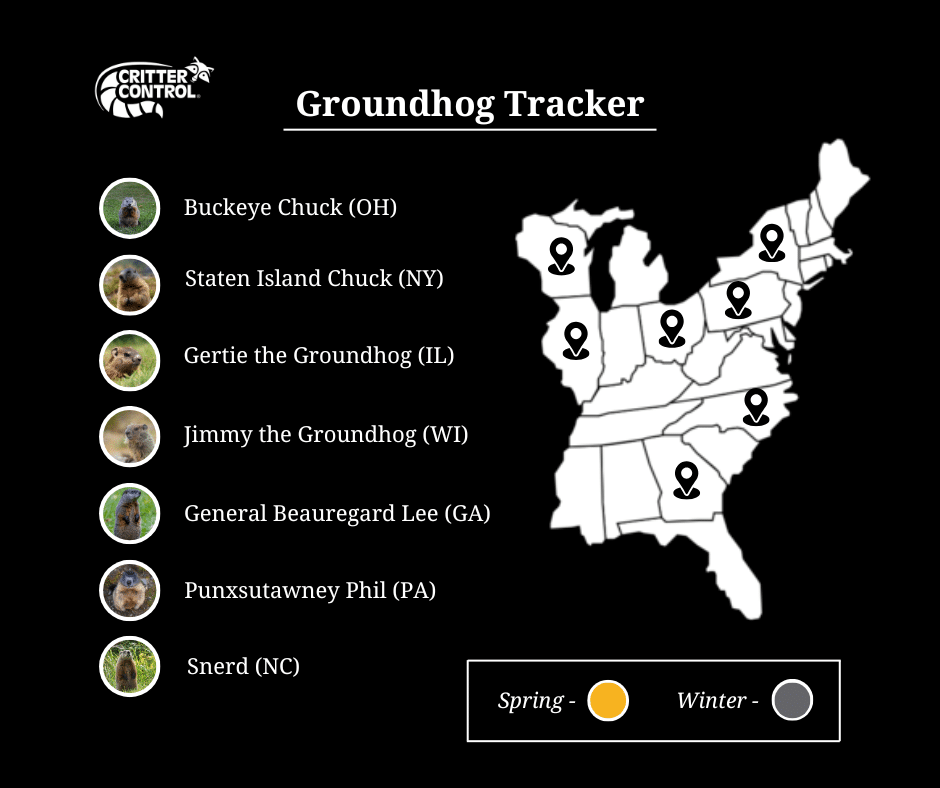Groundhog Day celebrated annually on February 2nd, is a fascinating blend of folklore, history, and community spirit. Known for its charming traditions and cultural significance, Groundhog Day has evolved from its European roots into a beloved event in the United States and Canada.
The holiday is based on folklore that a groundhog emerging from its burrow can predict the weather for the coming weeks:
- If the groundhog sees its shadow (meaning the day is sunny), it retreats into its burrow, indicating six more weeks of winter.
- If the groundhog does not see its shadow (cloudy day), it stays outside, suggesting an early spring.
Groundhog Day Prognostications across the Country
There are weather-predicting groundhogs and critters across the country. According to NOAA, the most accurate groundhogs are Staten Island Chuck in New York and General Beauregard Lee in Georgia. Punxsutawney Phil, while the most famous prognosticator, is not the most accurate. He’s been predicting the water from his burrow on Gobbler’s Knob since 1887!

Follow on Instagram for live updates
Comparing Groundhog Prognostications to NOAA
| 2024 | 2023 | 2022 | 2021 | 2020 | 2019 | |
| NOAA | Early Spring | Early Spring | Early Spring | Early Spring | Longer Winter | Longer Winter |
| Buckeye Chuck | Early Spring | Longer Winter | Early Spring | Early Spring | Early Spring | Early Spring |
| Staten Island Chuck | Early Spring | Early Spring | Early Spring | Early Spring | Early Spring | Early Spring |
| Gertie the Groundhog | Early Spring | Longer Winter | Early Spring | Longer Winter | Longer Winter | Early Spring |
| Jimmy the Groundhog | Early Spring | Longer Winter | Early Spring | Early Spring | Longer Winter | Early Spring |
| General Beauregard Lee | Early Spring | Early Spring | Early Spring | Early Spring | Longer Winter | Longer Winter |
| Punxsutawney Phil | Early Spring | Longer Winter | Longer Winter | Longer Winter | Early Spring | Early Spring |
| Snerd | Early Spring | Longer Winter | Longer Winter | Longer Winter | Longer Winter | Early Spring |
Can I Trust the Groundhog in my Backyard?
If you live in the Eastern or Central part of the United States, you might witness a groundhog appear in your yard. Groundhogs are true hibernators, and they just start to wake up in February. Groundhogs typically begin hibernation in late fall (around October or November) and remain in their burrows until early spring (February or March), depending on the climate.
We do not recommend checking a groundhog in your yard if it sees its shadow. Generally, they are not aggressive but they can be dangerous if threatened. If you do see a groundhog in your yard, call Critter Control. Their extensive burrows can damage your yard and undermine buildings.
The History of Groundhog Day
The origins of Groundhog Day date back to ancient European traditions, specifically the German custom of Candlemas Day. Held on February 2nd, Candlemas Day involved clergy blessing candles and distributing them to ward off the darkness of winter. It was believed that if the weather was fair on Candlemas, the latter half of winter would be harsh and cold. German settlers brought this tradition to America, adapting it to their new environment by replacing the badger with the groundhog, a creature commonly found in Pennsylvania.
Groundhog Day officially began in 1887 in Punxsutawney, Pennsylvania, thanks to a local newspaper editor who promoted the event. This led to establishing Punxsutawney Phil, the now-iconic groundhog, as the weather predictor. Over the years, the celebration grew from a local event to a national spectacle, attracting thousands of visitors eager to see Phil’s prediction.